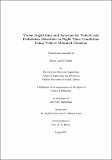| dc.description.abstract | Statistics show that a disproportionate amount of road fatalities occur at night-time despite the greatly reduced volume of traffic on roads. This thesis describes a system aimed at addressing this issue by automatically detecting the two main categories of road users: other road vehicles and pedestrians. A vehicle detection system using a visible spectrum camera and a pedestrian detection system using an infrared camera are presented, followed by a fusion of these systems.
An image processing system to detect and track vehicles using their lamps is presented. As the appearance of vehicle lamps in video can vary depending on camera hardware, a camera configuration process is implemented. To identify red tail- and brake-lamps, parameters for a red colour threshold are derived from automotive regulations. Higher intensity headlamps are identified by utilising a seeded region growing technique.
To obtain vehicle location data from identified lamps, they are paired using bilateral symmetry analysis. This is assessed by means of image cross-correlation, a shape and size independent approach to symmetry analysis. However, images of vehicle headlamps and tail-lamps suffer from perspective distortion during road manoeuvres, such as turning, engaging road bends and overtaking. A projective image transformation corrects for this perspective distortion, ensuring consistent detection performance through these road manoeuvres.
A night-time pedestrian detection system, based on the processing of Far-Infrared video, is presented. A pre-processing step is introduced, which compensates for distortion caused by clothing, using vertically-biased morphological closing. Regions Of Interest (ROIs) are identified using a region growing technique with high intensity seeds and feature-based stopping criteria. Histogram of Oriented Gradients (HOG) features are calculated from a database of images to train a Support Vector Machine (SVM) classifier.
Finally, advantages are attained by implementing a cooperative fusion of the visual vehicle detection and IR pedestrian detection systems. Vehicle location extracted from the visual system is used to mask the IR frame, removing warm vehicle parts such as lamps, tyres and exhaust pipes. This reduces the probability of false positives in pedestrian detection. Pedestrians detected in IR video are highlighted in the visual image, making pedestrians much more visible for human video consumers.
This research aims to contribute to a safer road environment at night for both drivers and pedestrians. | en_US |


